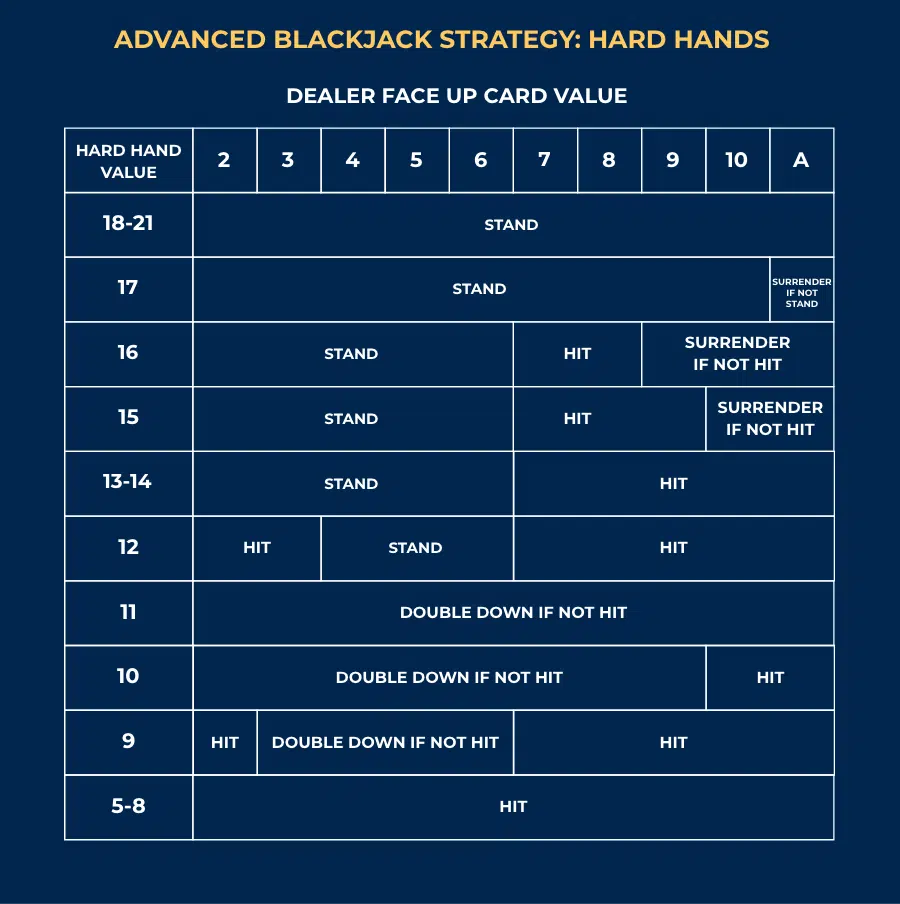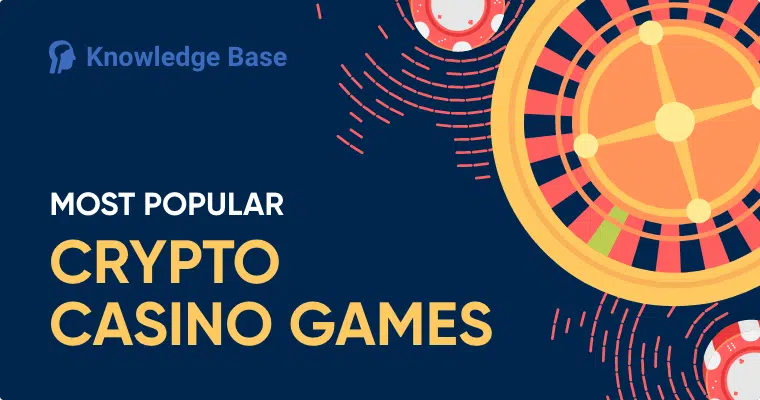Blackjack Strategy Breakdown: How To Increase Your Chances
Blackjack is a negative expectation game, which means that the house has the advantage over you. The house edge for blackjack games is relatively low compared to other casino games, but that doesn’t mean you should disregard it. A well-thought-out blackjack strategy is essential if you wish to beat the odds.
Whether you’re using casino sites that allow wagering in cryptocurrency or are physically going to gambling venues, you can use our blackjack guide to prepare for going head-to-head with the dealer.
What You Should Avoid Doing When Playing Blackjack
After you master the basic blackjack rules, it’s time to adopt a good strategy and learn how to use it. Apart from knowing when to take certain actions (which we’ll explain later in the text), a good blackjack betting strategy also involves knowing what to avoid. Therefore, we will first discuss what you should never do while playing blackjack.
1. Stay Away From the First Base Seat if You’re a Beginner
Unless you’re playing at an online casino, you’ll have to choose a seat.
Despite what many blackjack players think, mathematically, the seat you choose doesn’t influence your odds. However, if you’re an inexperienced player, your best bet is to avoid the first base seat, which is the first seat on the right-hand side.
The reason is that you’ll be the first to play, which means that you’ll be faced with making the decisions sooner than the other players. Therefore, selecting the third, fourth, or fifth seat, for example, will give you some time to think and recall the blackjack tactics you’ve practiced.
2. Never Play at a 6 to 5 Blackjack Table
The reason to stay away from 6 to 5 tables lies in simple math. For instance, if you wager $10, you’ll get $12 if you win, instead of the $15 you would get at a 3 to 2 table.
3. Avoid Playing at Tables That Have a Continuous Shuffle Machine
First of all, if your primary strategy is counting cards, your whole strategy goes down the drain if you sit at a table with a continuous shuffle machine (CSM). That’s because, in CSM games, the dealer puts the used cards in this machine to be shuffled every couple of rounds.
Even if you don’t use the card counting strategy, CSM reduces your chances of winning. The reason that these machines deal a higher number of hands per hour, which lowers the probability of beating the dealer.
4. Don’t Take Insurance Unless Your Card-Counting Game Is Impeccable
If you’re not familiar with this rule of blackjack or need a refresher, the insurance bet is an additional bet which can be placed if the dealer’s first face-up card is an Ace. The player bets that the dealer has a blackjack.
Making an insurance bet can be beneficial in some cases if used strategically by professional card counters. However, the odds of the dealer having a blackjack are typically 9 to 4, making this a generally unfavorable option.
5. Refrain From Splitting Pairs of Fours, Fives, or Tens
Splitting fives is less than a perfect blackjack strategy because this is a very good hand, and doubling down would be a much better idea. The only scenario where you shouldn’t double down is if the dealer has a nine, ten, or an Ace.
A pair of tens is another decent hand. Splitting it is likely to give you a less favorable hand, so it’s better to stick with it. The same goes for a pair of fours. You would need to get a five, six, or seven after splitting for this method to pay off.
6. Never Take Even Money Unless You’re Counting Cards
This option is presented to the player if they have a blackjack while the dealer’s face-up card is an Ace. If you choose it, you’ll essentially double your wager with no risk.
You may be tempted by the prospect of winning “sure money,” but let’s take a look at what this means mathematically. The probability of the dealer having blackjack is 30.74%.
Therefore, there is a 69.26% chance of winning without taking even money and getting a better payout for it. In the long term, even money doesn’t pay off, and you’re better off avoiding it altogether.
Basic Strategy for Blackjack
The ideal blackjack strategy can vary according to the game variation you’re playing, as there are many blackjack types to choose from. In this section, we will focus on a simple blackjack strategy for playing classic blackjack, which is suitable for beginners.
The first thing you should know when playing blackjack is whether to hit, stand, or double down. This will vary according to the number of decks being used.
Hard Hand
Let’s take a look at what you should do if you have a hard hand, i.e., a hand without an Ace. We will compare the total value of the player’s hand to a dealer’s face-up card. Here is what to do:
- If you have a total of four to eight, and the dealer is showing anything from two to Ace, you should hit.
- If your value is nine compared to a dealer’s two to six card, it’s best to double down, but you should hit if they have seven to Ace.
- When you have ten to eleven, and the dealer’s face-up card is lower in value than your total, you should double down; otherwise, you should hit.
- If your total is twelve to sixteen, and the dealer has two to six, it would be wise to stand, but hitting is a better option if the dealer is showing a seven to Ace.
- For a hand of seventeen to twenty-one, compared to the dealer’s two to Ace, you should always stand.
Soft Hand
As with a hard hand, you can employ a certain blackjack strategy if you have a soft hand. If your hand consists of one Ace that can be counted as eleven, you have a soft hand. That changes things a fair bit, so here are your options:
- You should always hit provided you have a thirteen to fifteen against the dealer’s two to Ace.
- For a sixteen to eighteen compared to the dealer’s two to six, your best bet is to double down, but if the dealer shows a seven to Ace, you should opt for hitting instead.
- If you have a nineteen to twenty-one, and the dealer holds anything from two to Ace, you should stand.
Chart
To make things more clear and easier to understand, here is a basic blackjack strategy chart depicting the strategy we’ve just discussed:
Know When to Surrender
Surrendering may not be the most desired option, but knowing when to forfeit the game to avoid bigger losses is an important element in any player’s strategy. Although you will still lose half of your bet, it’s better than losing everything. Therefore, this option should be used only when you have a strong reason to believe that you’re going to bust.
So, the question is, when should you surrender? As a beginner, you can memorize these two instances:
- You have a hand of fifteen, and the dealer uncovers a ten.
- Your total of fifteen is up against the dealer’s nine, ten, or Ace.
Blackjack Strategy for More Advanced Players
Once you’re comfortable with these basic strategy tips and know how to use them, you can move on to the more advanced techniques.
An advanced blackjack strategy involves more than knowing whether to hit, stand, or double down, although that is still a crucial skill to master. In this section, we will explain how to count cards and give you some of the best blackjack tips for advanced players.
How to Count Cards
Counting cards is frowned upon by the casinos. That’s because this technique gives an advantage to the players. However, you should know that counting cards is not illegal, although you might be asked to leave the premises if the dealer suspects you’re using this method.
Now that you know the risks, let’s dive into explaining this technique, in case you haven’t read any blackjack theory books. You’re probably aware that there are different card counting systems. The one we are going to present is called the high-low system. What card counters do is separate cards into three groups:
- High-value cards: tens, Jacks, Queens, Kings, and Aces
- Low-value cards: twos, threes, fours, fives, sixes
- Neutral cards: sevens, eights, nines
When counting, you’re assigning value to these three groups of cards. That value presents your advantage. Naturally, the higher the value, the more edge you have against the dealer.
You should assign a value of -1 to high-value cards. These cards are beneficial to you as a player, so when one of them has already been dealt, this means that there is less chance of you getting a card of the same value.
Low-value cards go in the dealer’s favor, so when these cards leave the game, your chances of winning go up. Therefore, you should count them as +1. Lastly, neutral cards have no value, as they don’t benefit the player or the dealer.
Charts
For more advanced players, there are even more detailed charts to consider. Here is an advanced blackjack strategy chart showing you what to do in the case of a hard or soft hand.
The basic strategy is easier to remember, but studying the advanced charts will ultimately make you a better player. It also has some alternative strategies you should take note of.
For instance, the difference between this and the basic strategy is that if your hard hand total is nine and the dealer has a two, it can be better to hit instead of doubling down. If you have a total of twelve against the dealer’s two or three, try hitting instead of standing.
In contrast to the basic blackjack chart for a soft hand, there are more instances of doubling down. For example, if you have a fifteen or sixteen, compared to the dealer’s four to six, you can choose to double down or hit.
Instances When You Should Take Insurance or Even Money
We know we’ve previously advised avoiding insurance and even money. However, if you’re an advanced player, there are a few cases when doing so can go in your favor. Keep in mind that you should do this only if you know how to count cards. The rule is to take insurance or even money at a true three or higher.
Tips for Memorizing Your Strategy More Easily
1. Use Color-Coded Charts
If you’re making your own charts, it’s a good idea to use different colors, each depicting one action, such as hit or stand. Most people are visual learners, so this method can really do wonders. You can also use the charts from this article and print them out in color.
2. Use Flashcards
Flashcards are quite an effective method when you need to learn some information by heart, as they make you actively engage in the learning process. Therefore, instead of simply reading the chart, you should write down the card combination on one side of the paper and the suggested action on the other.
Have the card-combination side face up and try to guess which action you should take in each case. Repeat the process until you’re able to get it right every time.
3. Create a Blackjack Cheat Sheet
If you’ve chosen a strategy that you’re having trouble recalling, don’t give up on it. Bringing a cheat sheet is allowed in most casinos, so you can jot down a few blackjack strategy charts on a piece of paper and use them during the game.
Final Comments
The perfect blackjack strategy doesn’t exist, but there are tactics you can use to bolster your chances of winning. If you’re having trouble with the more advanced techniques, you can still increase your odds of winning blackjack with a basic strategy.
Remember, though: even those armed with the best blackjack strategies can lose, and no tactic is foolproof when playing against the odds. Therefore, always be prepared to bet only what you can afford to lose, and never go chasing your losses.
FAQ
What is the best strategy for blackjack?
There is no one perfect blackjack strategy, and nothing will ever guarantee a payoff every time. Some methods work pretty well and can increase your chances of winning, though. Our article explains both basic and more advanced strategies that many players have found helpful.
When should you hit or stay in blackjack?
If you have a hard hand with a total of four to eight or a soft one worth thirteen to fifteen, and the dealer is showing any card from two to Ace, you should hit. On the other hand, staying is the best option when holding a hard seventeen to twenty-one or a soft nineteen to twenty-one compared to the dealer’s two to Ace.
Can blackjack strategies vary from one game to the next?
What the best blackjack strategy is varies depending on several factors. For example, whether you have a hard or soft hand, what variant of blackjack you are playing, how many decks are involved, and so on. Ultimately, any successful blackjack strategy has to be flexible and account for the game’s many variables.








